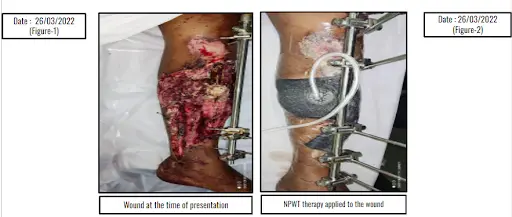Case Study of Open Trauma Wound – CCNPWT ORTHOPAEDICS
Aim of Therapy:
MANAGEMENT OF AN OPEN TRAUMA WOUND (BELOW KNEE INJURY)
Patient Information:
| First Dressing Application Date: | 26/03/2022 |
| Dressing Remove Date: | 08/04/2022 |
| Patient Name: | Mr. Anil Mangaraj |
| Patient Age: | 32 years (Male) |
| Wound Type: | Open trauma wound |
| Exudates Type with Wound Depth: | Haemoserous Discharge |
| Hospital Name: | AIIMS Bhubaneswar |
| Doctor Name: | Dr. Ritesh Panda |
| Doctor Specialty: | Orthopedic |
| Clinical Person Name: | Mr. Smruti Ranjan Ojha |
| Patient Profile: | Accidental Case |
| Dressing Type/Device: | CCNPWT (VTG-2901) |
| Pressure Range: | -130mmHg |
| Any Major Illness During Therapy: | No |
| Diabetic / Non -Diabetic | Non-Diabetic |
| Supportive Ongoing Treatment | Antibiotics (Cafahead, VitC) |
| Total Days of Recovery or Treatment Duration | 14 Days |
| Wound Location | Below knee |
Clinical Scenario:
A 32-year-old male presented to the orthopedic hospital with an open trauma wound following a below-knee amputation caused by a high-velocity vehicular accident.
Due to the accident, the patella to the fibula bone was fractured. The patient underwent the external fixation procedure to hold the broken bone in the proper position. Upon focus examination, the doctor noted the patient had progressive wound necrosis on the lateral-posterior surface of the right leg, extending up to the tarsal. The wound was caused by trauma, which resulted in tissue infection, necrosis in the surrounding area, an irregular shape, and the presence of heavy slough fluid. After the wound evaluation, the doctor recommended CCNPWT treatment for the fast wound healing process, obtaining granulation tissues, and preparation of the wound bed with primary closure.
Management:
Following debridement, CCNPWT (VTG-2901) therapy was applied, and therapy started with static -130mmHg pressure mode for 14 days. During the therapy session, the wound underwent a single session of dressing change (Fig. 1). The wound started to generate granulation tissue on the wound bed. After the removal of NPWT (VTG-2901), the wound bed was sufficiently populated with heavily granulated tissues, which were considered for further processing. There were no other complications, and CCNPWT (VTG-2901) was discontinued after 14 days. After further medication, the wound was referred to a plastic surgeon for the grafting process.

